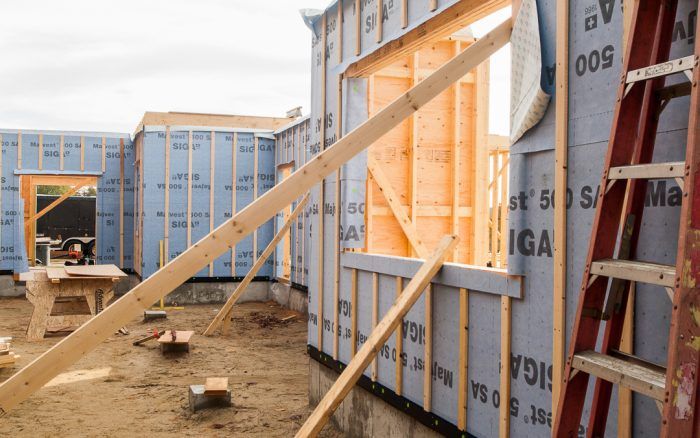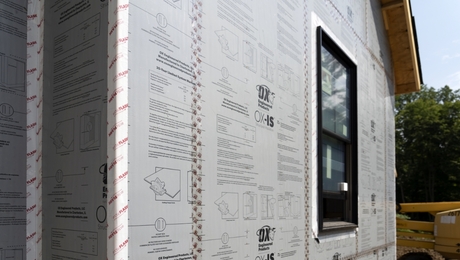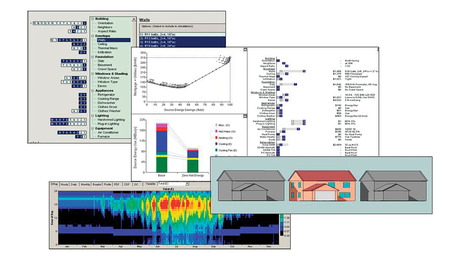Critics Claim Agreement Helps Home-Building Industry Block Tougher Energy Codes
In exchange for guaranteed seats on a code-writing committee, the National Association of Home Builders pledged support for later code changes.

This article originally appeared on GreenBuildingAdvisor.com
An undisclosed pact between the nation’s most powerful home builders’ lobby and the organization that writes model building codes has slowed the adoption of energy-saving requirements for new homes, critics have claimed.
The arrangement is between the National Association of Home Builders (NAHB), which represents some 140,000 U.S. builders, and the International Code Council (ICC), which publishes the International Residential Code, an influential model building code that has been adopted in many states.
In a published report last week, The New York Times said a deal first signed in 2002 guaranteed NAHB four of 11 voting seats on the committee that develops new versions of the IRC in return for NAHB’s support of the model building codes that ultimately win ICC approval.
The building codes are updated every three years and are not legally binding until they are adopted by state or municipal officials.
The dispute pits energy efficiency advocates against a construction industry seeking to keep building costs low. Even though the four guaranteed seats are a committee minority, critics say they are enough to block or slow down the adoption of new provisions that would require greater energy efficiency in new houses.
Whitney Doll, ICC’s vice president for communications, said the NAHB is “one of the groups that has reserved seats on the International Residential Code committee.” Doll would not disclose the full text of the agreement but she provided a summary that was prepared two years ago by Earthjustice, a non-profit environmental law firm with headquarters in San Francisco.
The summary said that the ICC agreed, among other things, that one-third of the voting members of the IRC code development committee would be qualified representatives offered by NAHB. In return, NAHB agreed to provide a “clear and definitive statement of support” for the adoption of the IRC at all levels of government.
In an amendment to the agreement in 2005, the ICC also agreed that the IRC code development committee would hear all proposed changes to the IRC rather than have them assigned to a different committee. The ICC Board of Directors agreed to “oversee the committee appointment process and provide a direct and permanent conduit through the ICC CEO for NAHB and other strategic partners to request appointments.” NAHB was declared a “strategic partner” of the ICC.
Ron Jones, a former board member at NAHB, told The NYTimes that the agreement makes it difficult to move energy-saving changes through the ICC. “The home builders took them hostage by saying, ‘If you don’t work with us, we will look elsewhere to promote other codes,’” he said.
The view was echoed by Bill Fay, the executive director of the Energy-Efficient Codes Coalition. He said in a telephone call that the upshot of the pact—what he called the “30,000-foot view”—was that the NAHB committee membership was blocking the very energy efficiency improvements that many government officials want.
In an email, Doll defended the arrangement and said that a certain number of seats on some of the ICC’s code development committees are reserved for representatives of industries that use the codes.
“Representatives from these industries go through the same application, review, and approval process as all others who apply or are nominated for committee seats,” she said. “The participation of these industry representatives is critical to the process, as their input helps ensure that code-change proposals reflect the evolving needs of their respective trades.”
Doll added that industry representatives do not make up a majority of any code-writing committee, and that final votes on all code changes are made by “governmental member representatives” with no financial stake in the outcome. “Non-governmental members who served on committees do not get to vote in this final round,” she wrote. There are roughly 8,000 voting members who ultimately determine the outcome of proposed code changes.
“Our code development protocols are designed to protect the integrity of the process and ensure that no single group is able to influence the code development process to favor a particular trade or industry,” Doll’s email said.
Analysis shows energy changes slowed
NAHB Chairman Greg Ugalde told The NYTimes that it is appropriate for the industry to have a voice in the code-writing process. He added that committee members selected by NAHB “make their own decision on how to vote” and don’t vote as a block.
Yet evidence cited by the newspaper shows that moves toward greater energy efficiency slowed to a crawl after the International Energy Conservation Code fell under the agreement in 2011. Prior to that, in code changes for 2009 and 2012, energy costs for homeowners had been reduced by 32% compared to a 2006 baseline because of more rigorous energy requirements, according to an analysis of the Department of Energy.
After the IECC became subject to the deal in an ICC reshuffle of the committee structure, however, projected residential energy savings went down by less than 1% in the 2015 code, and less than 2% in the next round of changes in 2018.
More rigorous code provisions for energy efficiency can save homeowners many thousands of dollars over time, far outweighing initial investments in more efficient appliances, more insulation, or better air-sealing.
But NAHB has objected to requirements that make new houses more expensive, and the association has crowed about the influence it has had on code changes. “Of the 259 proposals on which the association took a stand, the committees agreed 81% of the time,” a NAHB newsletter said in 2015. “And only 6% of the proposals that NAHB opposed made it through the committee hearings intact.”
In a 2018 “NAHB Now” newsletter, the trade group told its members that among its “advocacy victories” was the “preservation of lower cost options in building codes.” The estimated value to builders was $1,000 per housing start.
NAHB said it succeeded in blocking a number of proposed provisions that would have upped construction costs from the 2015 versions of the IRC and IECC. Defeated proposals included new U-factors for windows that would have meant a bump to triple-pane units in Climate Zones 5 through 8, high-efficiency water-heating equipment, and requirements that new homes accommodate solar installations in the future.
A sleeper issue that got legs
Although apparently long-rumored in the industry, the ICC-NAHB deal was first brought to light by Earthjustice after the organization began tracking down rumors two years ago.
“The existence of the memorandum was a secret, but not a particularly well-kept one in that there were a lot of people who had heard something to the effect there was an agreement,” Earthjustice staff attorney Timothy Ballo said in a telephone call. “There was a lot of strong indication that there was one, but no one had really seen it.”
Ballo said many members of the ICC board were state or municipal employees who are subject to open-records laws. Earthjustice began submitting Freedom of Information requests that would compel those employees to disclose what they knew about the memorandum. Eventually, the ICC contacted Earthjustice and the two began discussing how they would resolve the issue, “basically to make us stop,” as Ballo put it.
Ballo said he was permitted to review the document, make notes, and prepare the summary that was ultimately approved by both NAHB and ICC. This was the summary that Doll sent to GBA.
At first, Earthjustice did nothing with the information.
“The feeling was that if we discredit the ICC process or cast doubt on it we don’t really have a Plan B,” Ballo said. “The thinking was that by showing we knew of the existence of [the memorandum] by putting some pressure on the ICC we would get them to even out the process a little bit and wouldn’t have the major roadblock to efficiency in the next iteration of the codes.”
But the new version of the codes in 2018 suggested that it was going to be business as usual—slow progress on energy-saving code changes.
The thinking, Ballo said, was that “if we’re not going to make any progress on the IECC, there’s no point in preserving whatever dignity the ICC’s progress supposedly bestowed.”
Ballo then planned to write an Earthjustice blog about the arrangement. But he was contacted by NYTimes reporter Christopher Flavelle before it could be written or published. Ballo said he had no idea how the newspaper learned about the NAHB-ICC agreement and that he was actually surprised that such a “wonky” discussion on codes would even end up in the newspaper.
But Ballo said there is no question the agreement has slowed progress on forcing builders to make new houses use less energy.
“It’s made it very difficult, as I think the NYTimes piece said, for pro-energy-efficiency measures to succeed at that committee state,” he said of the ICC-NAHB arrangement. “You need essentially every committee member not connected with the NAHB to vote in favor of it. And the vote of that committee, while it’s true that the municipal code professional members of the ICC do get the ultimate say, the committee’s action where the NAHB has significant sway is dictating what threshold applies.”
Was the deal common knowledge?
The NYTimes article called the pact a “secret deal,” adding that when originally asked about it, the ICC denied having an agreement with NAHB. The efforts that Ballo describes to learn the details of the arrangement, as well as the ICC’s continued refusal to make the document public, suggests the parties are still sensitive about it.
Yet Ugalde and others scoff at the notion there was anything secret about it.
In a written statement released by NAHB, Ugalde said, “The idea of a ‘secret pact or agreement’ is ludicrous at best and harmful at worst.” The ICC hasn’t tried to disguise the fact that it has partnered with several groups, adding, “It would be more newsworthy if the governing body for the codes development process did not seek out the opinion of leading experts.”
“We have made no secret of our resistance toward the adoption of requirements into the IRC that are not cost-effective,” he said. “Housing affordability must be a cornerstone in any efforts to create cleaner and stronger homes.” He said increasing housing costs “by imposing unnecessary mandates is not only tone-deaf but harmful to American consumers.”
Michael Pfeiffer, senior vice president for technical services in the ICC’s central regional office, said the existence of the agreement is well-known.
“It is not a secret agreement,” he said in a telephone call. “We have not publicly disclosed an agreement but for anybody involved in the code development progress it’s common knowledge, once again not only this agreement with NAHB but other agreements as well because these agreements foster ICC’s ability to bring the talent to the table.”
Pfeiffer also took issue with the idea that NAHB committee members have an undue influence on energy policy because of the “checks and balances” built into the system. If tougher energy provisions are voted down in the first round of review—what are called the committee action hearings—they can be reintroduced later and voted on by the full ICC governmental membership.
The committees consist of 12 members, but the chairman votes only in the event of a tie. It takes a simple majority of the committee to approve or reject new code provisions. However, it takes a two-thirds majority of voting members at the public hearing stage to get that provision back on the agenda for a final vote.
So, for example, if the IRC committee votes against requiring triple-glazed windows or more insulation in new houses in the first round of review, it would take two-thirds of all governmental voting ICC members to reverse that later.
“The process weights the expertise of the committee,” Pfeiffer said. “If you want to propose something differently than what came out of the committee, it does require two-thirds because the process relies on the expertise that’s brought to bear by the respective committees.”
What’s next?
The review process for the 2021 versions of the I-codes is still underway, but the disclosure by the New York Times has clearly ruffled some feathers.
“Yes, there is going to be some fallout on this,” Fay said. “I don’t think it’s going to die and it shouldn’t. This stinks. It’s an astonishingly troubling document and I think that’s why it’s secret. I think it’s very disturbing.”
-Scott Gibson is a contributing writer at Green Building Advisor and Fine Homebuilding magazine.


























View Comments
The notion that climate change will drive everything is out of line and needs to be reined in. carbon is plant food which does not constitute a existenial danger to our way of living.
What is the life cycle costing of the increased insulation and other mandates that are made upon building construction? Historically a 7-year period Used to be a reasonable payback for increase construction costs. I never hear this discussed which shows a pendulum has swung way too far to the left.
This is exactly what happened in Pennsylvania the Builders Association was able to get their supporters on the Construction Code Review Committee and was able to stonewall the members in making the required recommendations and moving the State forward in the adoption of the latest building codes from the national code committee. The hand picked chairman of the committee was so blatantly biased that it was ridiculous. The builders got to the legislators to not permit the committee to be able to pass the latest code updates. They got to the Governor and I was not reappointed to the committee even though I was nominated by my State entity to represent our state wide membership and I was replaced by a hand picked builders representative. Needless to say , money talks and the legislators listen.